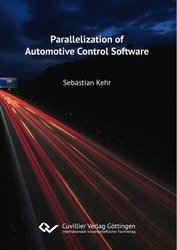| Areas | |
|---|---|
| Serie de libros (96) |
1378
|
| Nachhaltigkeit |
3
|
| Gesundheitswesen |
1
|
| Letra |
2364
|
| Ciencias Naturales |
5406
|
| Matemática | 229 |
| Informática | 319 |
| Física | 980 |
| Química | 1363 |
| Geociencias | 131 |
| Medicina humana | 243 |
| Estomatología | 10 |
| Veterinaria | 108 |
| Farmacia | 147 |
| Biología | 835 |
| Bioquímica, biología molecular, tecnología genética | 121 |
| Biofísica | 25 |
| Nutrición | 45 |
| Agricultura | 1004 |
| Silvicultura | 201 |
| Horticultura | 20 |
| Ecología y conservación de la tierra | 148 |
| Ciencias Ingeniería |
1793
|
| General |
98
|
|
Leitlinien Unfallchirurgie
5. Auflage bestellen |
|
Erweiterte Suche
Parallelization of Automotive Control Software (Tienda española)
Sebastian Kehr (Autor)Previo
Indice, PDF (45 KB)
Lectura de prueba, PDF (160 KB)
Automotive control software is developed according to the AUTomotive Open System ARchitecture (AUTOSAR) standard. High development costs require the re-use of existing software when the hardware platform changes from a single-core to a multicore electronic control unit (ECU).
This Ph.D. thesis focuses on the migration of AUTOSAR legacy software to a multicore ECU. Different parallelization methods are proposed and evaluated; RunPar and Supertasks on runnable-level, timed implicit communication on task-level, and the parallel schedule quality metric for quantification of combinations. The methods respect data dependencies and still enable parallel execution, they exploit the energy-saving potential of the processor, they guarantee latency constraints, and they reproduce the reference data-flow.
| ISBN-13 (Impresion) | 9783736994317 |
| ISBN-13 (E-Book) | 9783736984318 |
| Formato | A5 |
| Idioma | Inglés |
| Numero de paginas | 220 |
| Edicion | 1. Aufl. |
| Lugar de publicacion | Göttingen |
| Lugar de la disertacion | Ilmenau |
| Fecha de publicacion | 20.12.2016 |
| Clasificacion simple | Tesis doctoral |
| Area |
Informática
|
| Palabras claves | Automotive control software, AUTomotive Open System ARchitecture (AUTOSAR), data-flow |








